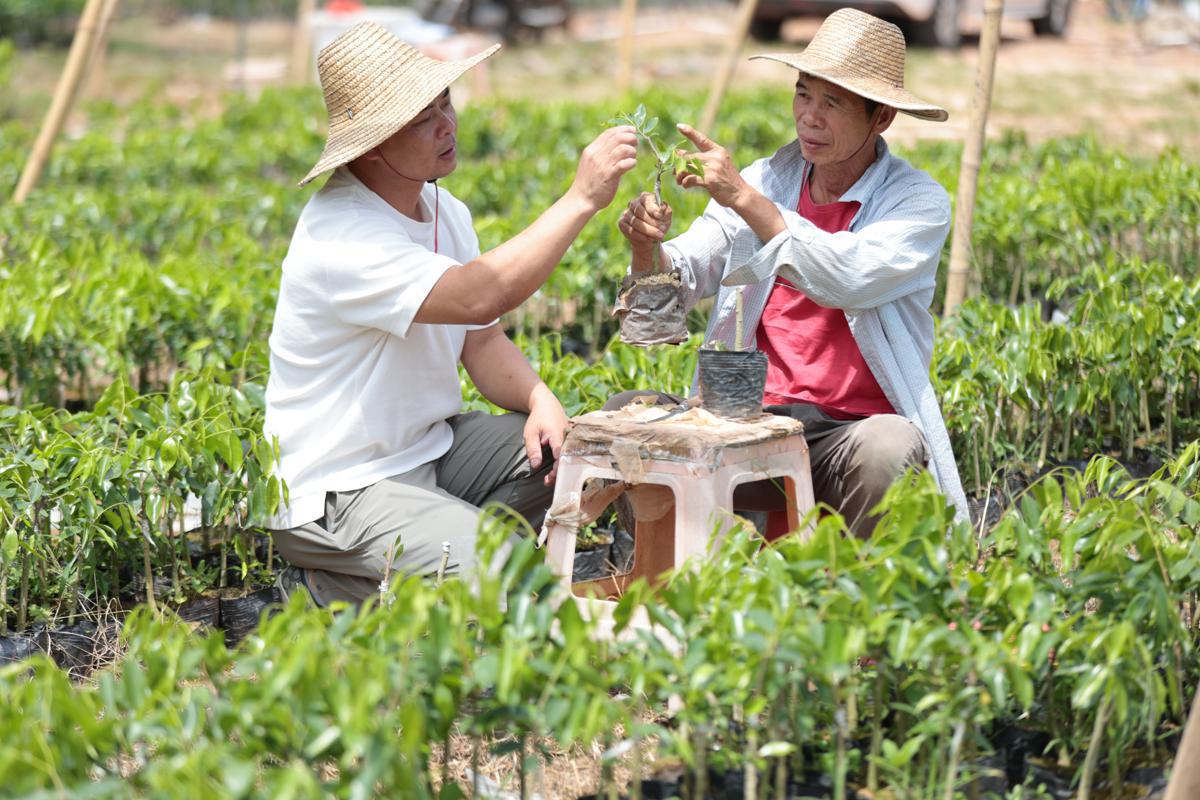Agarwood growers enjoy sweet smell of success


At a green kynam agarwood seedling base in Baiyun village of Huidong county, Guangdong province, Chen Qinmao bends over a young Aquilaria sinensis sapling, grafting a sliver of premium green kynam agarwood onto its stem.
Beside him, his father wraps the delicate union with twine and protective film — a process repeated thousands of times each year in this quiet corner of Huidong. Their work, meticulous and methodical, is more than a livelihood; it's a bridge between ancestral traditions and a sustainable future.
Chen, a third-generation agarwood cultivator and head of Huidong Green Kynam Agarwood Seedling Development Co, has become a linchpin in the county's drive to transform green kynam agarwood into an economic and ecological powerhouse.
His nursery produces 300,000 saplings annually, with a survival rate exceeding 200,000. Over the years, nearly 1 million seedlings have been distributed to local farmers, fueling a quiet agrarian revolution.
"These aren't just trees — they're a lifeline for our community," Chen said, wiping sweat from his brow.
Chen's journey began in Maoming, Guangdong, where his family cultivated agarwood — a fragrant resin used in traditional Chinese medicine, incense and luxury goods. Yet it was Huidong's reputation as the native home of green kynam, a rare and premium agarwood variety, that drew him eastward.
"Green kynam is unique to Huidong. The soil is rich in minerals, and the subtropical climate creates perfect growing conditions," Chen said.
After years of studying the local market and refining grafting techniques, he relocated permanently, establishing a 30-hectare plantation in Baihua town with over 100,000 trees.
His expertise in grafting, which involves fusing high-yield green kynam branches onto hardy Aquilaria sinensis rootstock, has boosted survival rates to over 80 percent, a critical factor in scaling production.
The shift from Maoming to Huidong mirrors the county's broader agricultural transformation. Once dominated by fast-growing eucalyptus plantations — a crop criticized for depleting soil nutrients and biodiversity — Huidong is now embracing agarwood as a sustainable alternative.
Local policies, including the Two-Year Action Plan for Green Kynam Agarwood Industry Development and the Eucalyptus-to-Agarwood Conversion Plan, aim to replace a part of eucalyptus forests with agarwood by 2025.
"This isn't just about economics; it's about healing the land," Chen said.
Green kynam's appeal lies in its rapid resin production. Some trees yield harvestable resin in as little as three years, compared to decades for wild varieties.
Its premium market value is important too. High-grade green kynam resin can fetch over $50,000 per kilogram, driven by demand from perfumeries, pharmaceutical companies and artisanal incense makers.
Yet its ecological value is equally profound. Agarwood forests act as carbon sinks, improve soil stability and provide habitats for native wildlife, including endangered species like the Chinese pangolin, which is found in Huidong's protected reserves.
To harness these dual benefits, Huidong's government has adopted a whole-chain approach. Collaborations with institutions like the Chinese Academy of Forestry and South China Agricultural University have optimized grafting techniques and resin extraction methods.
According to the county forestry bureau, nearly 1,100 hectares of green kynam now flourish across 128 enterprises. "Our goal is to build an industry that benefits both people and nature," said Xie Shangshan, a forestry engineer at the local forestry bureau.
He cites the case of a former eucalyptus farmer in Baihua who switched to agarwood in 2021.
"His income tripled within two years, and his land now supports birds and pollinators that hadn't been seen there in decades," Xie said.
For Chen, the true measure of success lies in grassroots impact. His nursery doubles as a training center, where farmers learn grafting, pest management and sustainable harvesting.
"Many villagers initially saw agarwood as a risky investment. Now, they're our partners," he said. Over 100 households have joined the trade, with some earning up to 200,000 yuan ($27,500) annually from resin sales — a staggering sum in rural Guangdong, he said.
The economic ripple effects are palpable. Local workshops have sprung up to craft agarwood-based products like prayer beads and essential oils, while Huidong's annual Agarwood Cultural Festival attracts buyers from across Asia.
Despite its promise, the industry faces hurdles. Counterfeit products plague the agarwood market, and smallholders often lack access to financing. To address this, Huidong's government has launched certification programs and low-interest loans for agarwood farmers.
Chen, meanwhile, is experimenting with blockchain technology to trace resin from tree to market. "Transparency will protect our growers and our reputation," he said.
"We're proving that ecology and economy can grow together," Xie said.
Li Aiping and Lai Rihong contributed to this story.





































